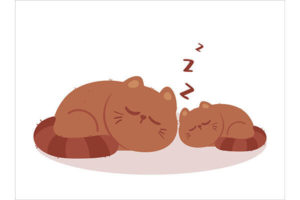The best way to say “dream” in Japanese is 夢 (yume). The Japanese word 夢 (yume) corresponds to the English word “dream” very well.
Therefore, 夢 (yume) can be used in similar situations where you would use the English word “dream.” You can use 夢 (yume) to refer to the images and sensations that occupy your mind while you sleep. Moreover, you can also use 夢 (yume) to talk about your cherished ambition or a wish that you desire to make a reality.
What’s more, is that you can use 夢 (yume) to express your indulgence or fantasy of something. For instance, you might want to say to someone “I’ve always dreamed of kissing you”, or something romantic along those lines.
In this ultimate guide, we look at deeper explanations and examples of 夢 (yume), as well as translations of other words that contain the word “dream.” I also include a section on how to dream in Japanese!
Other examples may include:
- the word for daydream in Japanese,
- how to say sweet dreams in Japanese before bed,
- or even how to describe someone as being dreamy.
All entries are coupled with audio for pronunciation reference!
Table of Contents
Dream in Japanese
- Dream.
夢。
yume.
As discussed in the introduction, the best word for “dream” in Japanese is 夢 (yume). In hiragana, it’s written as ゆめ (yume).
夢 (yume) is a noun that, just like the English word, can be used to refer to the series of images or sensations that fill your mind as you sleep. You can also use it to express a wish that you would like to come true in the future.
Conveniently, you can also use 夢 (yume) as a plural noun! For instance,
- 夢を見る島。
yume wo miru shima.
The Island of Dreams.
Notice how you can simply write 夢 (yume), yet the translation is “dreams” not “dream”.
This is because, in the Japanese language, there is no distinction between plural and singular. Therefore 夢 (yume) can be used to say either. For any of you The Legend of Zelda fans out there, the above example is actually the original Japanese title for the Gameboy Classic game Link’s Awakening!
Saying “I Had a Dream” in Japanese
- I had a dream.
夢を見た。
yume wo mita.
When you want to refer to the dreams that fill your mind when sleep, there are a few important things to keep in mind.
In English, we say “last night I had a dream”. However, in Japanese, we say “last night I saw a dream”, rather than saying “I had” one.
This is because, when you say “I had a dream” in Japanese, you’re specifically referring to the type of dream that is your future goal, your ambition.
Therefore, to talk about a dream you had in your sleep in Japanese, you have to use the verb 見る (miru).
- 昨夜、夢を見た。
yuube, yume wo mita。
I had a dream last night.
As a quick side note- it’s common to omit pronouns in Japanese when it is understood who/what is the subject. That’s why in the above example, 私は (watashi ha), meaning “I” is absent.
見る (miru) is a verb that means “to see” or “to look” in Japanese. を (wo) in a Japanese particle that marks the object of the verb. In this example, the noun 夢 (yume) becomes the object of the verb 見る (miru).
On the other hand, to say that you have an ambition, a dream you wish to fulfil, you can say:
- 私は夢がある。
watashi ha yume ga aru。
I have a dream (an ambition).
ある (aru) is an intransitive verb that refers to an inanimate object that exists. The が (ga) marks the subject of the verb. In this case, 夢 (yume) is the subject of ある (aru). You can use the sentence sequence: Nounがある (Noun ga aru) to say “I have noun” in Japanese.
This means that 夢がある (yume ga aru) can be directly translated to “I have a dream”.
My Dream Is… in Japanese
- My Dream is…
私の夢は...
watashi no yume ha…
When talking about a dream, an ambition or a wish you have, naturally, you’ll want to specify what it is. To do that, you can use 私の夢は...(watashi no yume ha…).
This sentence structure can be understood as “My dream is…” in Japanese.
私 (watashi) means “I” in Japanese, and 私の (watashi no) means “my”. This is because の (no) is a Japanese particle that indicates possession. Therefore, when 私 (watashi) is paired with の (no), the meaning changes to “my”.
To end this sentence, simply state what your dream is.
- 私の夢は日本に行くことだ。
watashi no yume ha nihon ni iku koto da.
My dream is to go to Japan.
You may have noticed the こと (koto) in this phrase. Although こと (koto) means “thing” in Japanese, here it is required to make the preceding verb a noun.
We have to make the verb 行く (iku) into a noun because we need to end the sentence with the だ (da) if speaking casually, or です (desu) if speaking politely. By ending the phrase with だ (da) or です (desu) which by themselves mean “is” or “be” in Japanese, the sentence becomes grammatically complete.
More Examples!
With 私の夢は...(watashi no yume ha…) you can freely express exactly what your dream is in Japanese. You may even want to express your hope or wish in Japanese.
For instance, if you’re asked at an interview what your dream is, you could say:
- 私の夢は日本語を流暢に話せるようになることです。
watashi no yume ha nihongo wo ryuuchou ni hanaseru youni naru koto desu.
My dream is to be able to speak Japanese fluently.
This is a longer sentence with plenty of grammar. However, the same principle applies to the ending of the sentence. You need to attach こと (koto) as the preceding word なる (naru) is a verb.
What is Your Dream? in Japanese
- What is your dream?
[name]の夢は何?
[name] no yume wa nani?
To ask a friend, family member or someone who you’re close with what their dream is, you can say [name]の夢は何? ([name] no yume wa nani?). Simply replace the text for “name” with the person’s actual name! In Japanese, instead of referring to someone as “you” it’s much more common to call them by their name.
Japanese is a language with different levels of honorifics you must adhere to depending on who you’re speaking with. Therefore, if you’re speaking with someone you must show respect to, like a stranger, teacher or manager, you will want to ask this question formally.
- [name] の夢は何ですか?
[name] no yume wa nan desu ka?
What is your dream? (formally)
The only difference between these two phrases is that the formal one ends with 何ですか (nan desu ka) rather than simply 何 (nani).
何 (nani) means “what” in Japanese, making the phrase a literal translation of “what is [name’s] dream?”.
Make a Dream Come True
In Japan, to enter a university, all applicants must take and pass the dreaded entrance exam. Perhaps it’s been your dream to get accepted into a particular university… you’ve taken the exam and are awaiting the results. On the results day, you receive your grades and see you’ve made it in! Congratulations! At this moment, you might say:
- 私の夢が叶った!
watashi no yume ga kanatta!
My dream came true!
叶った (kanatta) is the past tense for 叶う (kanau), the verb for “to come true” in casual Japanese. This verb is made of the kanji 叶, which means “grant” or “answer”. To say “my dream was granted” in polite Japanese, use the formal form: 叶いました (kanaimashita). This would make the full phrase: 私の夢が叶いました (watashi no yume ga kanaimashita).
More Examples of 夢を叶う!
You can also use かなう (kanau) to express your romantic side too. You could say to someone:
- あなたの夢を叶えってあげたい!
anata no yume wo kanaette agetai!
I want to make your dream come true!
The above phrase is made up of multiple parts. Firstly, あなた (anata) means “you” in Japanese. Although it is much more common to instead refer to the person by their actual name, you can use あなた (anata) to refer to your partner.
Secondly, の (no) is a Japanese particle that indicates possession. In this case, あなた (anata) + の (no) together is the same as saying “your” in Japanese. Thirdly, 夢 (yume) means “dream” in Japanese (as discussed in entry #1). 夢 (yume) is followed by を (wo) which is a Japanese particle that marks the object of a verb. In this case, 夢 (yume) is the object and the following verb 叶う (kanau) is the verb.
Difference between 叶う and 叶える
Next, 叶えって (kanette) is the potential form of the verb 叶う (kanau) that’s been conjugated to the te-form. I appreciate this is a lot, but bear with me!
The potential form of a verb expresses the capability of being able to do the verb’s action. For example, the potential form of “do” in English, is “can do”. The potential form of “make” is “can make” etc.
This means that the potential form of “come true” is “can come true” in English. Therefore, in Japanese, 叶う (kanau), becomes 叶える (kanaeru).
Finally, the te-form refers to verbs that have been conjugated to end with て (te) or で (de) depending on the verb. Japanese sentences typically end with a verb. However, by conjugating the ending verb into the te-form, you can chain multiple verbs together in the same sentence.
あげたい (agetai) is the final section of the phrase. あげたい (agetai) is the tai-form of the verb あげる (ageru), which means “to give to someone” in Japanese. The tai-form expresses a desire, therefore, あげたい (agetai) means “want to give” in Japanese.
When あげたい (agetai) follows a te-form verb, the overall meaning changes slightly to mean “want to do for” in Japanese. Therefore, this phrase implies that the speaker wants to make the other person’s dream be able to come true (for them).
Related: How to say Good Luck in Japanese [Ultimate Guide]
Scary Dream in Japanese
- Scary dream.
怖い夢。
kowai yume.
To refer to a scary dream you had in your sleep, you can use the word 怖い (kowai). By itself, 怖い (kowai) is an adjective that means “scary” or “frightening” in Japanese.
What’s great in Japanese is that you can say 怖い (kowai) just like that to refer to something you feel is scary.
- 怖い!
kowai!
That’s scary!
By attaching a noun to follow after 怖い (kowai) you can state something as being scary or frightful. To say “scary dream” in Japanese, you can simply take the word for dream 夢 (yume) and place it after 怖い (kowai) as part of the same word.
- 昨日すごく怖い夢を見た!
kinou sugoku kowai yume wo mita!
I had a really scary dream yesterday!
As explained above, to refer to a dream you had when you were sleeping you have to use the verb 見た (mita) (to see), rather than ある (aru) (to have). When you use ある (aru), you’re saying you literally have a dream, an ambition, a goal of some kind.
Nightmare in Japanese
- Nightmare.
悪夢。
akumu.
Some dreams go beyond what we might refer to as being scary. When you have a really unpleasant terrifying dream, you would describe it as a nightmare. To say “nightmare” in Japanese, you can use the word 悪夢 (akumu).
- よく悪夢を見る。
yoku akumu wo miru.
I often have nightmares.
The word 悪夢 (akumu) is made up of two kanji. The latter is 夢 (yume) which means “dream”. The first kanji, 悪 means “bad” in Japanese. You’ll see this kanji most commonly in the adjective for “bad”, 悪い (warui).
This means that the word 悪夢 (akumu) quite literally means “bad dream”.
Sweet Dreams in Japanese
In English, when we want to wish someone good night, we may wish them to have sweet dreams. In Japanese however, saying sweet dreams to someone before bed isn’t something that translates well at all.
If you do a google search on “how to say sweet dreams” in Japanese, you’ll get 良い夢を (yoi yume wo), or 良い夢をみて (yoi yume wo mite). It’s very important to know that although these translations are grammatically correct, they sound extremely unnatural and somewhat out of place.
Therefore, you should not use these to wish someone sweet dreams in Japanese. Instead, you can simply say a softer “good night”. This is the most natural way, and closest way to express “sweet dreams” in Japanese.
- おやすみ。
oyasumi.
Good night.
Although it’s common to translate this expression as “good night”, there is no mention of “good” or “night” in the expression at all. The お (o) is an honorific suffix that is used to beautify the following word – and that word is やすみ which comes from 休み (yasumi) which means to “rest” in Japanese.
Note that although the expression contains an honorific suffix, it’s still perfectly natural to use this expression even between friends and family without sounding weird.
Instead, a more direct translation of おやすみ (oyasumi) could be “rest up”. However, おやすみ (oyasumi) is still commonly said between people before sleeping in Japan, in place of “good night”.
Is there really no way to say Sweet Dreams in Japanese?
Although there is no way to directly wish someone to have sweet dreams in Japanese, there are a few alternatives that could be considered.
The first is:
- 楽しい夢を見てね。
tanoshii yume wo mite ne.
Have some fun dreams.
This phrase should probably be used sparingly and would be best reserved for when speaking with children. It’s not something you’d really use that often, if at all to friends or a partner.
As my partner and I are currently in a long-distance relationship, sometimes I tell them before sleep:
- 夢で会おう!
yume de aou!
Let’s meet in our dreams.
This is perhaps the closest natural translation of “sweet dreams” in Japanese. Of course, as you’re telling the person to meet in their dreams, it can come across as romantic. Therefore, even this translation will have situational uses.
Daydream in Japanese
- Daydream.
ぼーっとする。
bo-tto suru.
When you’re spacing out a little and find yourself in the midst of a daydream, someone may ask you 大丈夫? (daijoubu) which means “are you okay?” in Japanese.
To answer this, you may want to tell them that you were just daydreaming.
- ぼーっとしてた!
bo-ttoshiteita!
I was spacing out/I was daydreaming.
The root of this word is ぼーっと (bo-tto), which means “absent-minded”, “blankly” or “in a daze”. する (suru) is the Japanese casual verb for “to do”. Therefore this complete expression is actually a verb that means “to daydream”.
The expression ぼーっとする (bo-tto suru) can also be used to describe situations when you feel completely out of it. This could be because you feel ill or are unwell.
- 熱があるせいで、頭がぼーっとしてる。
netsu ga aru seide, atama ga bo-ttoshiteru.
I feel completely out of it as I’ve got a fever.
Dreamy in Japanese!
- Dreamy.
かっこいい。
kakkoi.
To describe someone as really attractive, or as dreamy in Japanese, you can use かっこいい (kakkoii).
You may have heard かっこいい (kakkoii) used to describe someone or something as “cool” in Japanese before. However, you can actually use it to describe someone as being “dreamy” too.
In contexts where someone appears to be “dreamy” to you, you can use かっこいい (kakkoii) to express it.
- 彼はまじでかっこいい!
kare ha majide kakkoii!
He is seriously so dreamy/cool.
Alternatively, you can also use 素敵 (suteki) to express “dreamy”. Like かっこいい (kakkoii), 素敵 (suteki) is also dependent on the context. This is because you can use 素敵 (suteki) to describe other things such as flowers, or a story from a book as being lovely or wonderful.
- 素敵な映画だった!
suteki na eiga datta!
That was a lovely movie.
On the other hand, if you are dazzled by the dreaminess of someone, you can say:
- 私の心が盗まれた! 彼は本当に素敵!
watashi no kokoro ga nusumareta! kare ha hontouni suteki!
My heart’s been stolen. He is truly dreamy!
Dream Person/Partner
- Dream Person/Dream Partner
理想の人
risou no hito
You can refer to someone as your dream or ideal partner by saying 理想の人 (risou no hito).
- 彼女は私の理想の人。
kanojo ha watashi no risou no hito.
She is my dream partner.
The 理想 (risou) in 理想の人 (risou no hito) is made up of two kanji. The first kanji 理 means “logic” and the second kanji, 想 means “concept”, “idea” or “thought”. Put together they make 理想 (risou) which means “ideal”.
Secondly, the の (no) is a Japanese particle that indicates possession and links two nouns together. 人 (hito) literally means person, so we can understand the complete phrase 理想の人 (risou no hito) to mean literally: “Person of ideal” or, “ideal person”.
In Japanese, 理想の人 (risou no hito) is used to refer to a dream person. You can also use this phrase to ask someone who their type is for instance.
- 理想の人はだれ?
risou no hito ha dare?
Who is your dream/ideal person?
Sometimes you may wish to refer to your partner as your soulmate, which can display a little more affection. I explain how to say everything to do with “soulmate” and “soul” in Japanese in this ultimate guide.
Imagination in Japanese
- Imagination.
想像。
souzou.
To dream big, sometimes we have to use our imagination. In Japanese, the word for imagination is 想像 (souzou). You can use 想像 (souzou) the way you would use the word “imagination” in English. For instance, you could say:
- 想像力を働かせて。
souzouryoku wo hatarakasete.
Use your imagination.
You can also use 想像 (souzou) to share your feelings with someone by saying something like:
- あなたがいない人生想像できない。
anata ga inai jinsei souzou dekinai.
I can’t imagine a life without you.
The first kanji of 想像 (souzou), 想 is the same kanji that appears in 理想 (risou) (explained above) and means “concept” or “idea”. The second kanji is 像 which means “image” or “shape”. Put together they make 想像 (souzou) meaning literally” concept image” or “imagination”.
Just My Imagination in Japanese
When you thought you had observed something to be as something, but conclude that you made a mistake, in English, we say “It was just my imagination”. For instance, say you’re trying to sleep at night, and you suddenly hear an unsettling noise. Your brain immediately jumps to the conclusion that something is out to get you, but you realise it’s just the thunder. You might think:
- 気のせいだ。
ki no sei da.
It was just my imagination.
The breakdown for 気のせい (ki no sei) is actually quite interesting. The first kanji 気 (ki) refers to the mind. The の (no) is a possession particle that can be understood as “of” in this case. Finally, せい (sei) refers to the fault of something. So quite literally 気のせい (ki no sei) refers to “the fault of the mind”.
Quite an interesting way to blame your imagination for perceiving something the way it’s not right?
How to Actually Dream in Japanese
In my experience to be able to begin dreaming in Japanese, you first have to immerse yourself into the language and develop a positive outlook on it. One of the most fun and effective learning techniques I’ve incorporated into my studies is to create mnemonics or references to refer to in order to remember and recall words.
The Dream Trigger
For instance, talking about new words you’re learning with friends can really help you to remember them as you develop a kind of relationship with the words.
As a result, these associations you’ve developed for the words tend to linger in the back of your mind. They inevitably resurface again as something triggers your memory to recall it. The trigger can be a simple conversation with friends or even a meme of some kind.
This can also come in the form of luck too. For example, say you have a word you’ve been trying to remember for so long, you keep looking at it, then coming back to it later, only to find you still lack the ability to recall it. You take a break and watch anime or a Japanese movie. Suddenly the word you’ve been trying to remember pops up and you instantly recognise it.
That experience on its own would have sharpened your memory of that word, making it significantly easier to recall.
Creating The Dream Trigger
Of course, this doesn’t always have to come down to chance. You can also create a trigger on your own too. For so long I couldn’t remember the word 複雑 (fukusatsu) which ironically means “complicated” in Japanese.
During a road trip with some friends, we played Avril Lavigne’s Complicated in the car which we all sang to. The chorus of this song includes lines that include the word “complicated”. I thought it would be a good idea to replace this word with the Japanese equivalent 複雑 (fukusatsu) every time the word came up.
Before I knew it I was able to recall this word easily. This was because I created a trigger.
When you start making these kinds of triggers with longer sentences, you’ll find that you’ll be able to recall much more. Speaking will come naturally to you at this point. When I reached a level where I was confident enough to have mostly effortless basic conversations in Japanese, the magic happened.
Dreaming in Japanese
The first time I was able to properly dream in Japanese was during my year abroad in Japan, which to my advantage, had me immersed in a complete Japanese-only environment. The only time I would speak English was when I would contact family members once a month.
At this point, I realised that my brain had adjusted to Japanese, and I found that I was able to recall some Japanese words faster than the English variants.
Then, I dreamt in Japanese for the first time. It’s important to know though, that I was still unable to have complete dreams in Japanese. Instead of a full-blown dream story in Japanese, the occasional Japanese word would pop up during the English story.
Later though, this began to transition to “Japanese-only” dreams. From my experience, to dream in Japanese, you have to reach a point where elements of your output ability (aka speaking) become second nature to you.
Dreams are at their strongest during REM, the deepest element of sleep. There is no scientific research on this yet, however, I personally believe that when you have enough triggers combined with an active/immersed Japanese learning environment, dreaming in Japanese becomes possible.
That’s just my thoughts though, what do you think? Can you dream in Japanese?
More Japanese Study
I have a collection of Ultimate How-To Japanese Guides tailored for all language levels.
More Ultimate Guides:
How to Say Hope in Japanese [Ultimate Guide]
How to Say What’s up in Japanese [Ultimate Guide]








